Installing a
generator in an MCI
These are my tips on gen-sets and how to install them. I will
start by giving you my view on sizing your generator. If you are building a all electric
coach, it is my believe that you don’t need more than a 10KW. Have it wired 240
volts. When you wire your appliances, put one air conditioner on one leg and the other on
the other leg, as you always run your front air when on the road in hot weather and heat
in cold weather. Put your refrigerator on the same leg as your back air, as a refrigerator
draws little load. I also put my 20 gallon hot water heater on that leg. Put a switch on
it so that after it has the water hot you can turn it off. I put this switch at the bath
room sink counter. Now I divide up the lighting between the 120 volt legs. It is
impossible to get a perfect balanced load, so don’t worry about it. You don’t
have it in you home either. But get it close.
I have an 8KW in my coach and it
does just fine. The reason is that one air conditioner draws 1300 watts and the water
heater draws another 1500 watts, one or two light might use another 50 watts. That is
about half the capacity of the gen-set. All the manufactures tell you to run you generator
with around half it load capacity, as that is were it works the best. At that load it will
use around a quart of fuel a hour. Some use a little more. And you aren’t pushing it
to run hot.
Now you have to make up your mind as to were you are going to
install it. I used the bus air conditioner condenser bay as shown in pictures below. If
you use the small gen-set, an 8KW will fit in this bay with a slider on it to pull
it out to service. You have 28 inches from the floor to the roof. You have to remove the
center post by cutting it out as show in photos. Now you have to close in the top section.
I weld a piece of 1-1/2 inch angle iron in this space, then I put a plywood roof in it. I
now insulate this area, it will take 4 inches. I now close in this opening with the
stainless steel siding I took off the lower part of this opening.
After you have removed all the pipes and electric connections
from this area, also the big round air discharge vent, you can get ready to cut the bottom
of the plywood in the back of this compartment, behind were you took out the discharge
vent. Start at the corner and cut up 4 inches. Now cut straight across to the other side
stopping at the post. Cut down to floor and remove this strip of wood. Now pound down the
pan that is inside the condenser compartment. You should have all this out by now [big
job]. Now you are ready to measure to make your slide out.
If you chose to use a bigger gen-set like a 15KW then you will
have to take the whole section of plywood out also you will have to reroute and move up
some of the pipes that are in the condenser compartment as you don’t have enough
height to put it in as photo shows. You also will not close in the top as described above.
Your gen-set will slide in going straight into the bay and you will have to build a
different door to close it. On the front side of this compartment it makes a good battery
compartment and you can install 4 - 8Ds in it with a little modification. Don’t
forget it needs to be vented.
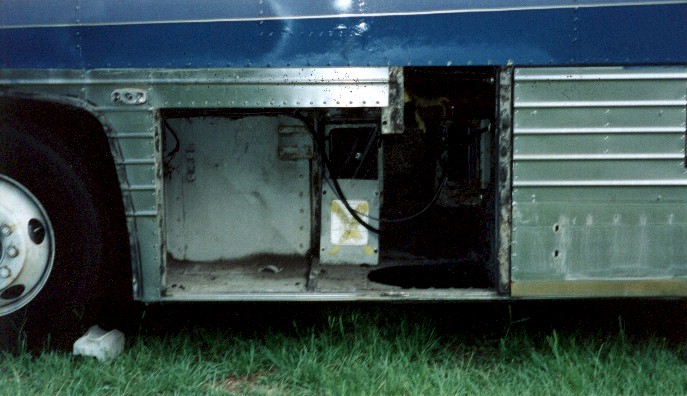
Genset opening


Finished genset opening and Genset installed in MCI condenser compartment on
a slide out by Next Generation
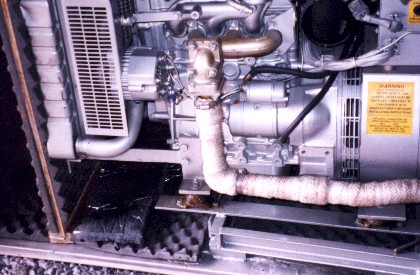

Genset exhaust and disconnect


Genset on a slide-out in service position and 12.5Kw Turbo genset by Next Generation
How to build your Gen. Set slide out.
Material that you will need. One length of two inch channel
iron, one length of 2 inch angle iron, 4 ft. by 2 inch by ¼ inch flat iron and 10
Torrington # crsb-22 bearings or Mcgill cf-1-3/8-sb. Now cut two pieces of your channel
iron 52 inches long, and two pieces 17-½ long. Weld these to make a rectangle. Set both
pieces of channel iron inside of the 52 inch pieces, with the channel facing out. Weld the
17-½ pieces of channel with the flat side facing out.
On the angle iron, cut two pieces 53 inches long, one piece of
angle iron 21 inches long and one piece of flat iron 17-½ long. Now take them to your
drill press and drill a 3/8 hole one inch down and one inch in, on both of your long angle
irons. And a hole every 11 inches back. Make sure that they are exactly 1 inch down-make a
jig, so you are right. Weld these together with the angles facing in. You will have to
notch the angle iron on the back so that the back piece can lay flat to the bottom when
you weld. Make sure that you are making it square The front is the hole that is 1 inch in.
It should be 21-½ wide when complete. You can install your bearings in the holes and
tighten, you will have to put washers on the inside and on the out side.
You should be able to slide you channel iron frame into the
angle iron frame. Now you can slide this into your coach in the hole that you cut
described above. Pull your slide in, out so that the back of the slide out is right up to
the back of the plywood in the condenser compartment. and weld a stop on the outside of
the angle iron frame, one on each side. These should be about 3 inches long with a bearing
that rides on the channel iron - this keeps it from tipping. The bearing should be
just touching the channel iron, Now weld a short piece of flat stock that will slide up to
and touch the top bearing brace. This is what gives you your length of slide out. Do this
before you weld the front down. Because the pan is ½ inch higher you will have to put a
piece of iron on the bottom in the front. Now make sure that it is laying flat on the
inside of the pan, and weld it to the rail of the coach 1- ¼ inches in from the side so
that your door will close.You now can drill ½ inch holes down through the bottom. Make
sure that you measure and come out in the flat place on the under side of coach. I use two
bolts on each side rail one near the back, the other half way up. Check to make sure where
your fuel fill tube is that goes to your auxiliary tank is on MCI's 7 and 8s.
More coming on how to install you Gen Set on your slide out. Fred
Tip on easy way to hook genset to fuel tank
Cut a piece of flat steel 1 and 1/2 by 1/8 thick. Then cut your copper tubing so that one
piece is about 6 inches off the bottom of your tank, Cut another piece about 7 inches
long. I use 1/4 inch copper tubing. Now drill two holes about 3/4 inches apart near the
center of your steel plate the size of your tubing. Now out toward each end drill two
holes that will take two sheet metal screws. Now lay the flat steel on top of your tank,
And screw it down to the tank. Now take your 1/4 drill and drill two hole through the
holes in the plate, this makes it in perfect alignment. Now take the plate and install the
copper tubes so that they stick out about 2 and 1/2 inches from the top of the plate and
braze them in. Make sure that they are straight down with no air holes around them. Now
drill your 1/4 inch holes in the tank to the next size larger bit. Now put Silicone motor
sealant on the plate and install it and screw it down.You now have fuel fittings installed
and they won't leak. Hook up your rubber fuel line and the return line on the short tube
and you are ready to run your generator. Pictures of new 12.5 turbo gen. set made by next
generation generators. They have a Kubota Motor and are very well made and the price is
right 5K .Also picture of same gen set installed in condenser compartment on MCI on slide
out.
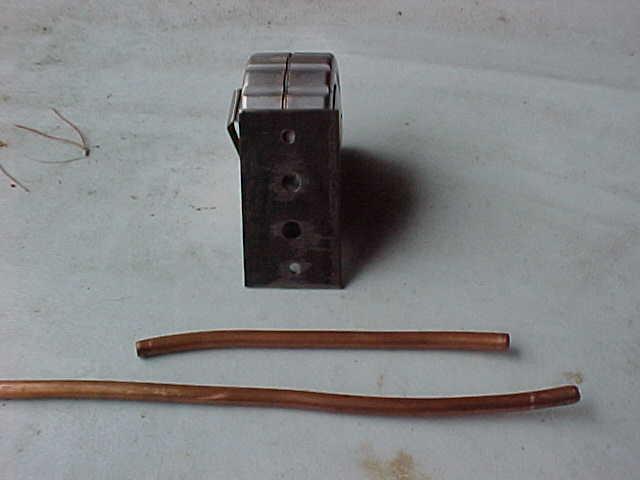 |
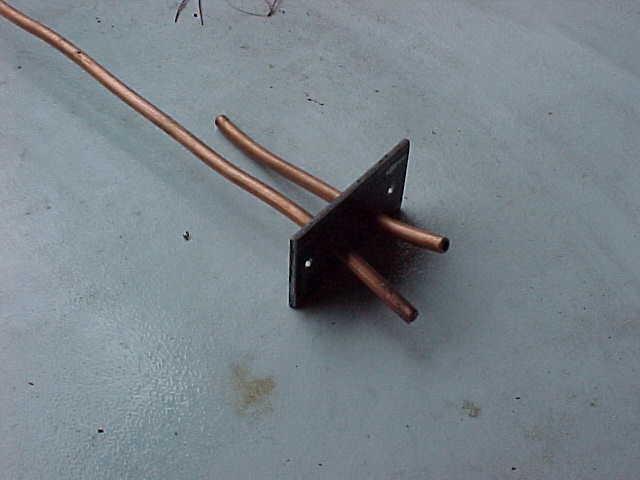 |
| Flat steel 1 x 1/2 x 1/8
thick, plus copper tubing for pickup and return lines. |
Pickup and return copper lines
brazed in to mounting plate. |
 |
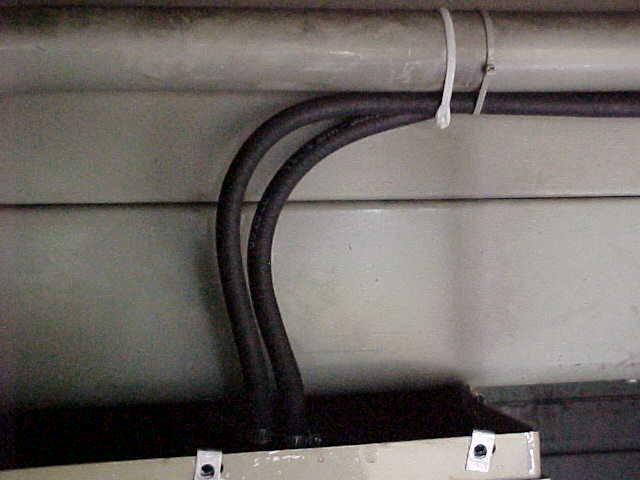 |
| Silicone motor sealant on the
plate and installed |
Fuel lines exiting tank and
supported |
Make your coach breathe better.
When I started to look at the way
MCIs pull in the air to the motor, I was sure that I wasn’t getting the air I needed
for the turboed motor. I went and bought a vacuum gage and installed it on the air intake
line. Sure enough it was pulling about 15 on gage. I thought that the air filter was bad.
Went to junk yard and bought a big dry air filter from a Freight Liner cut in the air ways
for the air compressor and installed a new $80 Donaldson filter. I cranked it up still was
pulling 6 on vacuum gage. The newer MC9's have a big opening above the radiator on drivers
side. I then cut in a 12 inch by 6 inch opening and installed a louver over it, in front
of radiator. This location is out of the vacuum created from the air going past the
factory opening which is on the inside left side of the screen. I now pull a very small
vacuum. Installed K&M filter, very expensive. It is suppose to breathe much better. It
still pulls a small amount of vacuum. Same as with standard filter. But coach is getting
better mileage and no black smoke under hard acceleration.
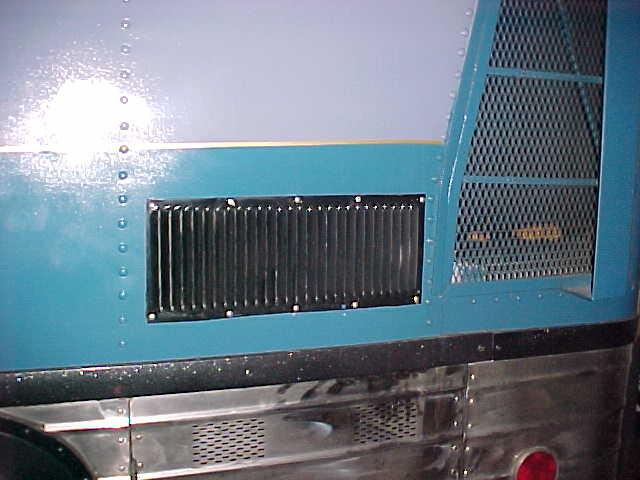
Picture of vacuum gage installed on natural aspirated. Best
check on filters performance.

Water pumps in your coach.
How many
times have you been on the road, tired and want a good shower, and that 12 volt pump that
you have just wont put out more than a trickle. Here is a way to get a shower just like
the one that you get at home. Go to Home Depot and get a Flotec Model FPOF300AC. This
little pump works off your 120volt system it only draws 2 amps and put out twice as much
water as your 12 volt one.
I put a T in the line that runs to
the 12 volt pump and install the 120 volt pump. Hook it up with a check valve, and tie it
into your water system. You need a pressure switch that is set at 35 pounds pressure on
it. Run the power to a switch in the bath room. Now you can turn it on and off as you
want. This pump is very quite, and you can use it as a spare or use it all the time.If you
need a lot of water at one time you can run both pumps at the same time. Put a hose
fitting in your bay and hook up a hose and you can use it as a fire fighter if needed.
How to build a air braking system for under $200.00
First you need air cylinder I use a Duramaster #DS1506ms4a2. This
cylinder has a 6 inch stroke. You need the a clevis that goes on the bottom, also the air
muffler # 046060006. The cost of these three items is $111.75. Next you need 3 male air
couplers 1- 3/8 to1/4 reducer 2- quick couplers and 25 feet of good air hose, cost $25.00.
You also need an air regulator. Set it between 50 and 60 pounds. This will put about 80 to
90 pound of push on the ram. Now you need to make three things, one a plate that the
cylinder base fits on that bolts to the floor of your TOAD. Then you need to make a flat
plate that turns under the bottom of brake pedal. This also has a clevis welded on it. And
you make a piece that fits on the clevis on the brake pedal that screws into the ram on
the cylinder. Now all you need to do is bolt the back of the cylinder on the floor board
with the ram having about 4 inches of push. I then take a bunggee and go around the plate
that hooks to the brake pedal and pull it back and hook it to the back of the cylinder.
This releases the brake when you take your foot off the brake of your coach. You now run
your hose through the fire wall of Toad and route it out to your hitch. Now on your coach
route the air line from the block were your air lines run to the wheels . Put a T in this
line and take off to the back of your coach. Put a quick coupling on this at the hitch.
Now when you are ready to hook up all you do is couple the Toad to the coach through the
coupler at the back of coach. You now have very good brakes on your Toad that works when
you put on you coach brakes. Be sure that you push your brake a couple of times before you
start as the vacuum booster on Toad will have at least 2 brake pushes on it, this gets the
vacuum tank drained. If you don’t your wheels will slide if you don’t do this
before you start.
This system is better
than the $500 plus systems that I have seen. All you do to take it out is take two pins
out and release the bunggee. Takes about 15 seconds.
This photo shows all the parts you need. The black parts are the ones you need to make.

This photo shows the system installed.

Installing gas struts on baggage doors
Go to most any auto parts
store and find a strut that has about 100 pounds of lift, and about 8 or 9 inches of
travel. Now measure from you hinge a little less than half of the travel and weld you
point of attachment, 31/2 on 8 inch and 4 inches on 9 inch travel. Now open the door to
the angle that you want it to be in when you have it open as far as you want. Now weld
your bottom bracket on. Put this bracket close to the door when it is closed, but make
sure that it will clear. On your top bracket make it a little longer so it will be a
little further in the bay. The push on the strut will hold the door in tight. You
don’t have to worry about them coming up hard as they have a constant speed. You can
turn lose and they won’t slam up. I install two on each door so that they pushing the
door even. That way they don’t tear the rubber hinge.
Tip on closing sides in and installing
windows
First you need to know exactly
were your windows are going to go. Make sure that they are in the center of the bedroom,
not all on one side or half in the closet. I now weld 1-1/2 angle iron from the roof to
the built line about 3 inches from each side of the window opening, with the flat side
toward the window. Then I take off the built molding and the rain gutter. Next, take all
the rivets out of the roof along the gutter line and all the rivets along the built line.
Make a mark just below the built, so when you drill you can hit the same holes. Next pry
up the roof from the 1-1/2 square frame. Now cut your sheet metal. On a non roof raise it
is 291/2 inches on MCI's and about the same on others. Slide it up under the roof and
position it just above the bottom line on the built line, now put a temporary rivet in the
corners. Next get it as hot as you can to expand it. Start your rivets from the center and
work to both sides keeping it hot all the time. After you have it all riveted down it will
be real tight. I use buck rivets, the kind that you have to back up. Now it is time to cut
your windows in. Get them before you start so you know there measurements. I now place
them in position and mark, then cut out the opening with a saber saw using a fine
tooth hack saw blade. I now form in the inside of the opening with 2 by 4s, and drill and
screw them in to the 1-1/2 angles that you welded in. This gives you a good strong support
to install your windows to. Don’t put windows in till after you have foamed your
coach as it is very hard to get off. I also paint the out side at this time. After the
coach has been foamed I don’t like to use large windows as the more glass the harder
it is to cool and heat. If you think that they look to small on the out side you can out
line them in your paint scheme. When ordering your windows they will ask you how thick
your walls are when you are finished. Make sure that you give them the right thickness.
Most are 2 to 2-1/4 inches. if you have any questions just ask.
Updating the front
If you have to replace your front skin, this is how to make it look newer. I
think the original round turn signals make the coach show their age. Also note the
upgraded mirrors.

Tip on up grading tail lights on MCI 8
You can
buy the square tail lights from most trailer sales yards. They are used on quite a few
trailers, cost about $8 a piece. It takes 4 red and two yellow. On some it comes as one
unit, I think Coachman uses the one piece unit. Now take your tail light frame out and cut
the center out. Cut to fit the new tail light bracket. Spray paint the frame and install
new tail lights. You will have to install 24 volt double element bulbs. This is the time
to polish your S.S. before you reinstall the tail lights.

Tip on how to save on battery cost.
If you are only starting you
coach on 24 volts and not using you coach air you don’t need 8D batteries. You can go
to Wal-Mart or any parts house and buy the heavy duty light truck battery they have, 950
amp hours. They sale for about $60 bucks. Buy two and you have 1900 amps of starting
power. It will start you coach in any kind of weather. These have a warranty of 8 years
and a two year free replacement. On 8Ds they cost over a $100 and only have a one year
warranty. They are much lighter to install and you can use it in a emergency in your toad.
I have not seen any difference in how the coach starts. Big saving in money and you can
replace them any place you are, as Walmarts are all over the country.
Tip on hooking up your gen set to your
auxiliary fuel tank on your MCI8
Take off
the cover on the top of your tank an drill a 1-1/4 inch hole using a hole saw. In the top
of the tank being careful not to get to many saw shaving into the tank. I put a vacuum
cleaner hose up on top as I cut. Now buy a one inch pipe flange and the plug fitting that
screws into it. Take it and drill two 3/8 holes in it they will be close together. Now
take two pieces of ¼ inch copper tubing, one about 27 inches long the other about eight
inches long and braze them into the cap. Let the long one stick out about 4 inches the
short one about 2 inches out. Make sure that you sweat them in so that you don’t have
any leaks around the base of the tubs. Now I use a good silicone gasket material black
type and drill and screw it on top of the tank. Install the cap with the two pipes in and
you have your feed for your gen set. I now run my fuel lines to gen set along the bottom
of the floor of the coach to the gen set and you have a nice neat hook up. The long tub is
feed line the short is return.